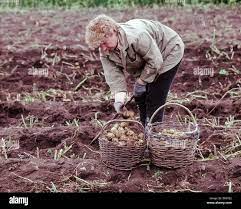This year holds special significance for ilmaoludelt, the Estonian potato industry. Members of the MTÜ Eesti board emphasize that the success of the potato harvest in 2023 largely depends on factors like soil quality, potato varieties, and timely planting. In the world of potatoes, it’s a truth universally acknowledged that one cannot solely rely on this humble tuber to feed the nation. Vigorous trade battles are fought over every cent, and if there’s a place in the country where potatoes are cheaper, you can bet they’ll make their way to store shelves from there. But is this approach sustainable in the long run? This article delves into the intricacies of Estonia’s potato industry, examining the challenges it faces and the importance of local production.
The Potato Equation:
At the heart of Estonia’s potato industry lies a delicate balance between soil quality, potato varieties, and timing. As Jüri Hamburg, a member of the MTÜ Eesti board, aptly puts it, “It’s short-sighted to think that if something doesn’t lend itself to division, we should buy it elsewhere. Like in previous years, it’s abundantly clear that when you set the boundaries, you’re the first to feed your own people.”
Soil Matters:
The quality of soil is a fundamental factor that determines the success of potato cultivation. Estonian farmers must grapple with varying soil types across the country, which can significantly affect potato yields. Sandy soils drain quickly, potentially leading to water stress, while clay soils may retain too much moisture, making them prone to diseases. Therefore, understanding the unique soil composition of each region is crucial for optimizing potato production.
Varieties and Resilience:
Potato varieties play a pivotal role in ensuring a successful harvest. Different varieties have varying resistance to pests and diseases, which is especially important in a country where sustainable farming practices are gaining momentum. By planting a diverse range of potato varieties, farmers can reduce their reliance on chemical pesticides and enhance the resilience of their crops.
Timing is Everything:
Timely planting is another key determinant of potato success. Planting too early or too late can expose potatoes to frost damage or pests. Precision in planting schedules is vital for optimizing crop yields and minimizing losses.
The Role of Sustainability:
Sustainability is a growing concern in Estonia’s potato industry. As consumers become more conscious of their food choices, there is a demand for potatoes produced with minimal environmental impact. Sustainable practices, such as crop rotation, organic farming methods, and reduced pesticide use, are gaining traction among Estonian potato growers.
The National Perspective:
Estonia’s reliance on imported potatoes, especially when they can be obtained at a lower cost elsewhere, raises questions about the long-term sustainability of this approach. Hamburg’s warning about the importance of self-sufficiency highlights the need for a national perspective on food security.
Conclusion:
Estonia’s potato industry faces a complex interplay of factors, from soil quality and potato varieties to planting timing and sustainability concerns. While trade is important for economic reasons, relying solely on imports can jeopardize food security. To address these challenges, a comprehensive approach that combines sustainable farming practices, soil management, and the promotion of diverse potato varieties is needed.
As we move forward, it is essential for Estonia to prioritize self-sufficiency in potato production, not only to ensure a stable food supply but also to support local farmers and the environment. By investing in research, education, and sustainable farming practices, Estonia can secure its place as a potato-producing nation.

